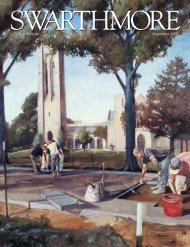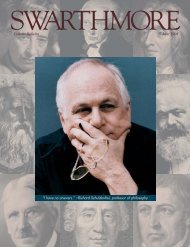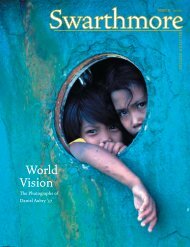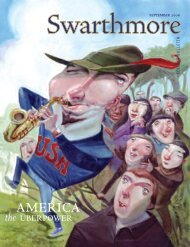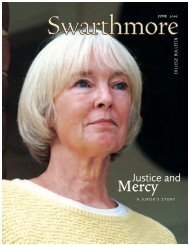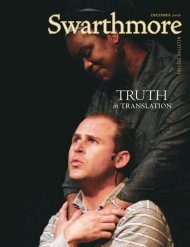A Walk in the Woods
Swarthmore College Bulletin (March 2001) - ITS
Swarthmore College Bulletin (March 2001) - ITS
Create successful ePaper yourself
Turn your PDF publications into a flip-book with our unique Google optimized e-Paper software.
CORNELL VISITING PROFESSOR OF ENGINEERINGWLODZIMIERZ WOJCIK CHALLENGED HISSTUDENTS TO FIND WAYS FOR THE COLLEGE TOMEASURE ITS “ENVIRONMENTAL SUSTAINABILITY.“THEIR RESULTS WERE PRESENTED AT A CAMPUSCONFERENCE IN DECEMBER (LEFT).mented <strong>the</strong> green<strong>in</strong>g efforts of adm<strong>in</strong>istration,staff (especially <strong>the</strong> Scott Arboretum),and <strong>the</strong> student group Earthlust but noted“a lack of collaboration and communication”among <strong>the</strong>se groups.The biggest surprise for Wojcik—who isat Swarthmore as part of <strong>the</strong> Polandexchange program—was <strong>the</strong> students<strong>the</strong>mselves. “I thought <strong>the</strong>y would be moreaggressive and would oversimplify, but<strong>in</strong>stead <strong>the</strong>y seemed to understand <strong>the</strong>complexities of <strong>the</strong> problem. They saw that<strong>the</strong>re is not one simple solution, that <strong>the</strong>reare many constra<strong>in</strong>ts and connections, andmany factors <strong>in</strong>volved <strong>in</strong> environmentalissues.”Jesse Hartigan ’04 summed this up at<strong>the</strong> presentation. “We live <strong>in</strong> various systems,from <strong>the</strong> most general, <strong>the</strong> universe,to <strong>the</strong> most specific, local ecosystems,” hesaid. “With<strong>in</strong> each of <strong>the</strong>se systems is aseries of <strong>in</strong>terrelated components, physical,psychic, and spiritual…. The well-be<strong>in</strong>g ofeach depends on <strong>the</strong> well-be<strong>in</strong>g of all <strong>the</strong>o<strong>the</strong>rs.”—Cathleen McCarthyTHINKGLOBALHEALTHPulitzer Prize–w<strong>in</strong>n<strong>in</strong>gsciencejournalist Laurie Garrettwarned a packedKirby Lecture Hall last November of animpend<strong>in</strong>g global health crisis and <strong>the</strong>perils of ignor<strong>in</strong>g it. Garrett’s talk“Public Health—For Whom?” mixedhard, epidemiological data and sociologicalanalysis with <strong>in</strong>dividual storiesand photographs culled from her awardw<strong>in</strong>n<strong>in</strong>gbook The Com<strong>in</strong>g Plague (1994)and her latest Betrayal of Trust: The Collapseof Global Public Health (2000).Garrett described AIDS as “<strong>the</strong>biggest killer <strong>in</strong> <strong>the</strong> history of ourspecies” and said that <strong>the</strong> epidemic isstill <strong>in</strong> its <strong>in</strong>fancy. She also noted that<strong>the</strong> United States spends more onhealth than any o<strong>the</strong>r country, yet one<strong>in</strong> five is still without health <strong>in</strong>surance.As part of <strong>the</strong> College’s Media Fellowprogram, Garrett also met with studentjournalists over lunch before her talk.Previous fellows <strong>in</strong>clude 60 M<strong>in</strong>utesreporter Mike Wallace and Tom Bettag,executive producer of Nightl<strong>in</strong>e. “Hercommand of <strong>the</strong> political climate, economics,and all <strong>the</strong> details is just brilliant,”said Kathryn Tong ’01, a politicalscience major. “Swarthmore students,because of our sense of community, areextremely <strong>in</strong>terested <strong>in</strong> <strong>the</strong> issues sheraises, such as access to health care <strong>in</strong><strong>the</strong> Third World. She’s def<strong>in</strong>itely an<strong>in</strong>spiration.”—Alisa Giard<strong>in</strong>elliFORMERPROFESSORRETURNS ASCONGRESSMANCongressman Rush Holt [D–N.J.], whotaught physics at <strong>the</strong> College from1982 to 1986, returned to Swarthmore<strong>in</strong> February to offer an <strong>in</strong>sider’s look at<strong>the</strong> government. Holt was re-elected <strong>in</strong>November as a democrat from New Jersey’s12th district, by a marg<strong>in</strong> of only750 votes.Civility, which he def<strong>in</strong>ed as “not justpolitics [but] courtesy and conformitywith <strong>the</strong> rules of social order,” is “generallylack<strong>in</strong>g” <strong>in</strong> <strong>the</strong> government, he said.Without it, he warned, Congress will becont<strong>in</strong>ually engaged <strong>in</strong> campaign<strong>in</strong>g andwill approach all issues <strong>in</strong> a partisanmanner. He also voiced concern aboutPresident Bush’s “divisive policies,”which he believes must be exam<strong>in</strong>edcarefully.He spoke with more warmth about hisexperience at <strong>the</strong> College. “Swarthmorewas a great place to be,” he said. Whilehe taught here, Holt was an adjunct for<strong>the</strong> government, us<strong>in</strong>g his academicbackground to give advice on topicssuch as arms control.He cont<strong>in</strong>ued as a government liaisonwhile serv<strong>in</strong>g as assistant director of <strong>the</strong>Pr<strong>in</strong>ceton Plasma Physics Laboratory,before runn<strong>in</strong>g for Congress <strong>in</strong> 1996.Holt ended his talk by encourag<strong>in</strong>g facultyand students to devote a little timeto politics.—Jonathan Ehrenfeld ’04seasonal effects, Jeuland suggests add<strong>in</strong>gwater-leach<strong>in</strong>g wetlands plants. “The typesof plants be<strong>in</strong>g used <strong>the</strong>re could make a significantdifference,” he says. “There hasn’tbeen much research <strong>in</strong> that area, so it’s hardto know which plants work best.” For hissenior design project, Jeuland plans to producea “constructed wetlands for stormwatertreatment”—us<strong>in</strong>g wetlands plants.Claire Sawyers, director of <strong>the</strong> ScottArboretum, welcomes <strong>the</strong> <strong>in</strong>put. “Based onour success with <strong>the</strong> biostream, we’re discuss<strong>in</strong>gputt<strong>in</strong>g a storm-water retentionpond on Parrish lawn, near Mertz Hall,”she says. “That would give us <strong>the</strong> opportunityto try additional plants that could serve asbioscreens. If students are able to identifysuch plants, that would be great.”—Cathleen McCarthyCLUMPS OF ORNAMENTAL GRASSES, YELLOW FLAGIRIS, AND JOE PYE WEED WERE PLANTED IN THEBIOSTREAM TO IMITATE A NATURAL STREAMBED(RIGHT). IN 1999, THE PLANTING SURVIVED WHATARBORETUM DIRECTOR CLAIRE SAWYERS CALLS“THE CAPACITY TEST,” WHEN HURRICANE FLOYDDROPPED 6.6 INCHES OF RAIN IN 24 HOURS.STEVEN GOLDBLATT ʼ67M A R C H 2 0 0 19



